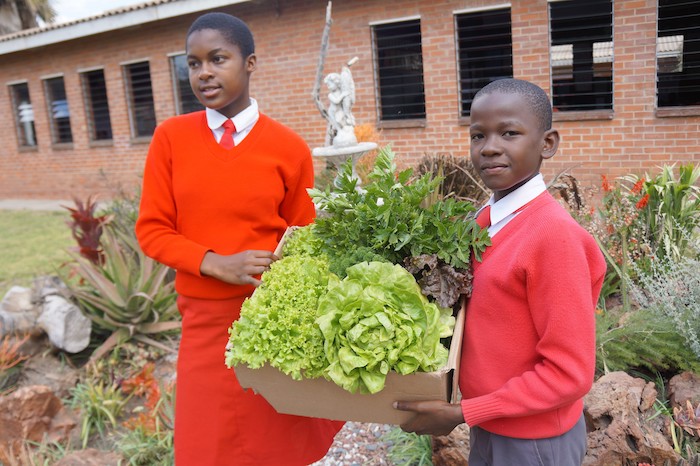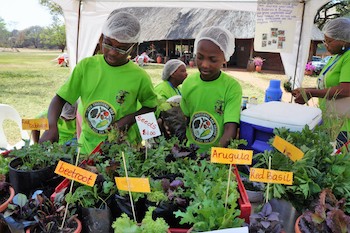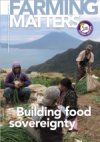In Zimbabwe, children across the country are putting food sovereignty into practice. They are redesigning their schoolyards based on permaculture principles to regenerate the soil, harvest rainwater and produce their own food. Children from more than half the schools that have gone down this path are now able to supplement their lunches with freshly picked produce.

In the face of climate change and chronic malnutrition in Zimbabwe, the schoolyards of 107 schools across the country are being transformed into green landscapes of edible food forests. Schools and Colleges Permaculture (SCOPE) is a practical education programme of the Zimbabwe Institute of Permaculture. Working in partnership with the Ministry of Education in Zimbabwe, SCOPE has been implementing projects with young people in schools throughout the country. We use climate friendly agriculture and youth empowerment activities to address school-based supplementary feeding and household level food sovereignty. Educational centres and schools are developing integrated land use designs aimed at transforming schoolyards into healthy, productive agroecosystems. In addition, SCOPE works to facilitate and influence a school curriculum that is centred on building an understanding and application of the ecological principles on which sound land use practices and food production systems are based.
Children are working on practical solutions to address and meet their needs at their schools using locally available resources
Children are working on practical solutions to address and meet their needs at their schools using locally available resources and inspired by permaculture. Permaculture is a system of ecological design that demonstrates how the relationship and co-existence with nature can model how to meet human needs. At the same time permaculture designs aim to regenerate the environment around us in the face of a changing climate. Permaculture lies, not in any single technique, but in looking at how multiple techniques can be woven together into systems that are more than the sum.
How it works
The schoolyard is transformed into a local school food system. The land is divided into food forest zones that protect it from erosion. The school lawn zone and flower beds are transformed into productive food gardens where cereals and vegetables are produced. The food forest zones are where multipurpose trees, mostly indigenous species that are well adapted to the environments, and fast growing fruit trees are planted. This has allowed most of the schools to enjoy diverse fruits throughout the year.
One fifth of the schools have integrated fish farming into their systems, where the water from the fish ponds is used to water vegetable gardens. The fish waste fertilises the plants, and the plants clean the water. These systems use 70-90 % less water than conventional farming and can produce large amounts of food within the small school spaces.
Nurturing the water, soil and fauna

Children learn how to value water, and to be in control of their own water systems. In a world where water is becoming ever more scarce and precious due to climate change, children are taught how to engage and practice water harvesting earthworks such as swales, ponds and keyline systems. The most common feature in all of the schools practicing permaculture is infield rainwater harvesting, coupled with planting of banana and paw paw around the school buildings to harvest roof water.
Another common practice coupled with food production is the use of greywater from the school. Water from hand washing points is captured, filtered with simple systems and used to grow trees, shrubs, and herbs.
As a way of working with the soils and rebuilding them as carbon sinks, the young people are taught to feed the soils through continuous mulching, composting, and use of green manures. Where possible, schools have managed to restore significant numbers of predators and keystone species needed for food productivity. For example, lizards and chameleons have come back to their environments to feed on the pests. Unlike massive geo-engineering schemes, these are practical solutions that are affordable and teach learners to observe and work with nature to produce food.
Not too young to be involved
SCOPE’s work is an attempt to encourage generations of system thinkers by bringing the ethics and principles of permaculture design and regenerative systems into the classroom. It is an attempt to empower the young people of Zimbabwe to determine and create a future of their choice. At the centre of each schools’ work is the demonstration of good practices. Children create safe green spaces abundant in food and water, using locally available resources. In addition, SCOPE works with children to create awareness of climate change action. An important success factor has been the acknowledgement that children and youth can actively support initiatives that lead to building resilient and sustainable communities.
Challenging the status quo
Applying permaculture has been difficult because practices such as mulching and intercropping have been perceived as dirty and less systematic than monocropping and maintaining bare soil. This led to limited support and somewhat negative attitudes from school administrators. Making more creative use of resources at hand, rather than doing what everyone else is doing also challenges the status quo.
Grow your own, cook your own, eat your own
Under the ongoing SCOPE campaign, “grow your own, cook your own, eat your own,” we facilitated the participation of the schools’ children and youth in the national food and seed festival. This gave them an opportunity to share, with other youth and elders, the inspiring work that they are doing on seed saving and food production. This was also an opportunity for young people to demonstrate cooking of local dishes.
We cultivate a large diversity of plants in the schools. In some places there was inadequate knowledge of local and indigenous plants. Although the design process brings parents and elders back into the school to share their knowledge and seeds, in some cases, local communities no longer have diverse seeds for sharing.
SCOPE continues to support more sharing of lessons learnt for implementation of good practices. The schools that are able to maintain their production independently act as learning and demonstration centres for the other schools. Besides this, different schools are connecting with and learning from each other through social media such as WhatsApp.
Students have learnt to think holistically about their landscape and their food
Youth as agents of change
In the past year, half of the schools were able to provide food to supplement the Government’s school feeding programme through the produce from their schools’ gardens. But beyond producing food, students have learnt to think holistically about their landscape and their food. This will be useful for self-reliance in their future careers, and in their lives, and it is also the first step towards building food sovereignty in our society.
Linda Kabaira (Linda.kabaira@gmail.com) is the national coordinator for Schools and Colleges Permaculture (SCOPE ) Zimbabwe.

